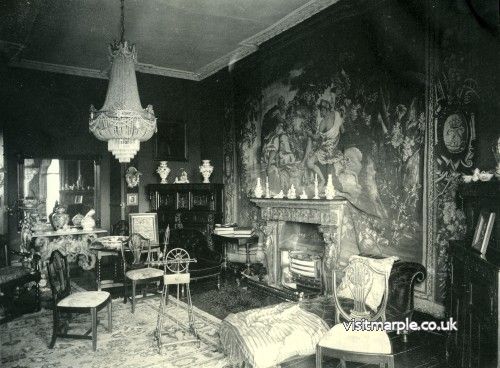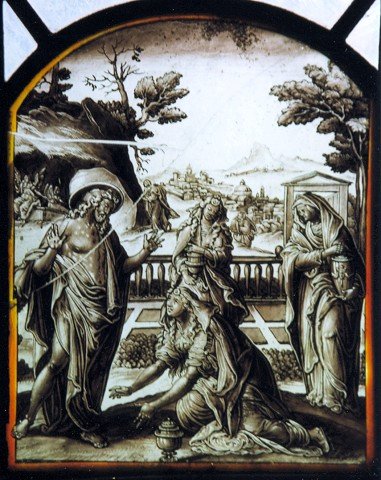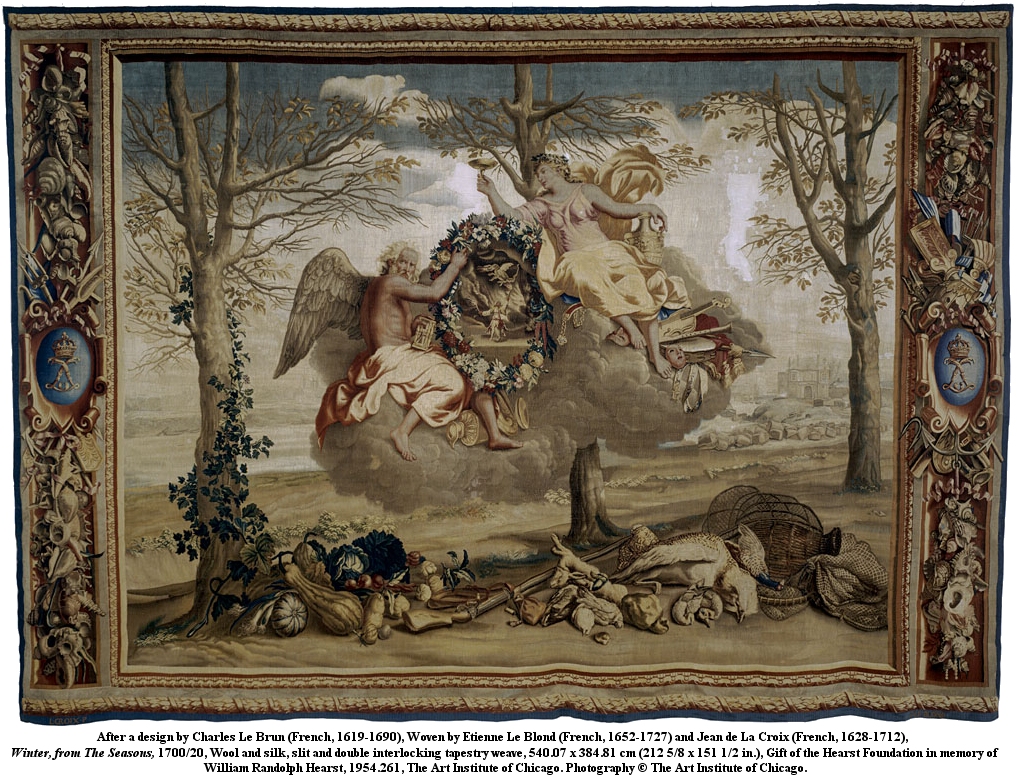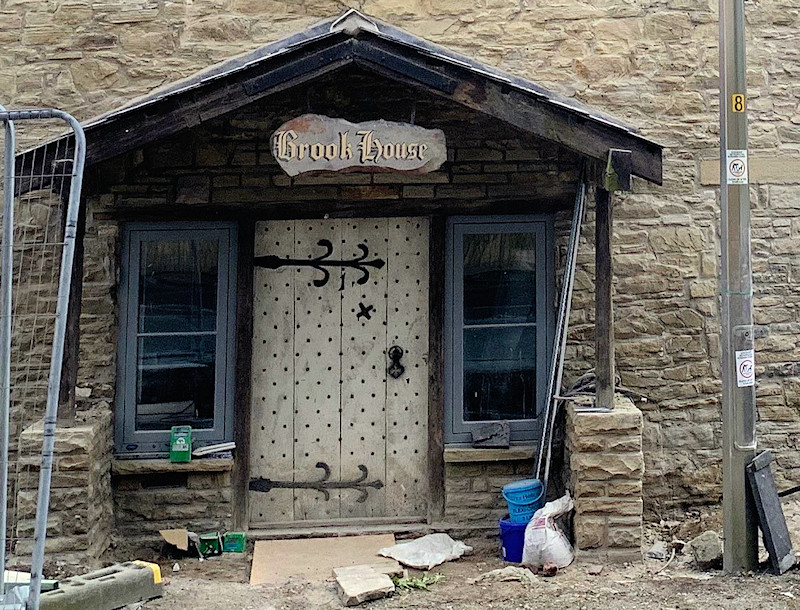As a community we lost Marple Hall in the late 1950s. It was sad but inevitable as the fabric of the house had been deteriorating for years and many other country houses had met the same fate. However, on the bright side, we have been locating and, in some cases, reclaiming, a number of items from the house. There were two main periods which saw the wholesale distribution of artefacts across the country and, in some cases, worldwide.
 Marple Hall Dining Room with many items including a tapestry cut around the fireplace
Marple Hall Dining Room with many items including a tapestry cut around the fireplace
Click image to see: Exterior of Marple Hall
 RHS North Window 10" x 8" (25.5cm x 20cm) Sepia coloured arched panel depicting an outdoor scene, possibly overlooking Jerusalem, with three female figures, one who appears to be kneeling at Christ's feet. Click the image to see both south imagesThe first period was the end of July in 1929 when the owner at that time, Henry Bradshaw-Isherwood, took the decision to sell the complete contents of the house as he was no longer interested in it. His timing was exquisite, if not perfect. The ‘Roaring Twenties’ ended in the United States on 4th September 1929 when stock market prices began to fall and reached a climax on ‘Black Tuesday’, 29th October. The Britisheconomy followed a similar pattern a few days later.
RHS North Window 10" x 8" (25.5cm x 20cm) Sepia coloured arched panel depicting an outdoor scene, possibly overlooking Jerusalem, with three female figures, one who appears to be kneeling at Christ's feet. Click the image to see both south imagesThe first period was the end of July in 1929 when the owner at that time, Henry Bradshaw-Isherwood, took the decision to sell the complete contents of the house as he was no longer interested in it. His timing was exquisite, if not perfect. The ‘Roaring Twenties’ ended in the United States on 4th September 1929 when stock market prices began to fall and reached a climax on ‘Black Tuesday’, 29th October. The Britisheconomy followed a similar pattern a few days later.
The sale was a spectacular success, taking place over two days and raising the magnificent sum of just under £10,000 (about £700,000 in current values.) The most spectacular lots were two superb tapestries made by the Gobelin factory in the latter part of the eighteenth century. These sold for 600 guineas each (£41,000) to a dealer. In turn he sold them to William Randolph Hearst, an America multi-millionaire and the Rupert Murdoch of his day. In 1954 the Hearst Foundation gave the tapestries to the Art Institute of Chicago. It was only when the Art Institute were researching the provenance of the tapestries that they found the Marple website, saw Mark Whittaker’s account of the sale and contacted him to ask for details of the sale.
We have recently been able to establish a connection between Agatha Christie and two items she bought at that same sale. Her grandson, Matthew Prichard arranged to come to Marple to take part in the 150th celebrations of Marple Station. He brought with him a letter held by the Christie Archive Trust which demonstrated once and for all where her eponymous Miss Marple got her name. Almost as an aside there was a reference to chairs which had been in Marple Hall sale.
Dear Mrs McMurphy,
I expect you will be interested to learn that at the time I was writing The Thirteen Problems (starting with a series of 6 short stories for a magazine) I was staying with a sister of mine in Cheshire and we went to a sale at Marple Hall – the house alone, she said, was worth seeing, a beautiful old manor, belonging to the Bradshaws descended from Judge Bradshaw who sentenced Charles I.
It was a very good sale with fine old Elizabethan and Jacobean furniture and at it I bought 2 Jacobean oak chairs which I still have – wanting a name for my ‘old maid’ character I called her Jane Marple.
So now you know the answer to your question!
Yours Sincerely
Agatha Christie
This was obviously something that had to be checked out, but where? The obvious place for her to take the chairs when she had bought them was Greenway, her summer home near Dartmouth. But it was not as easy as all that. Although Greenway is now owned by the National Trust, it is almost three hundred miles from Marple. Even when you get there the house is not easy to access. It is reached along single lane country roads; the NT only provides parking for really exceptional visitors; there is a Greenway Halt on the local tourist steam railway but it has not been used for decades. The only practical way to get there was by ferry from Dartmouth and then a climb up a steep hill. And this is exactly what your intrepid explorer did. All he had to do now was find the chairs.
Greenway is an attractive and spacious house built in the style of the 1920s. There is some Art Deco styling in a few of the rooms but it is not a design icon; much of the furniture is very ordinary. However, two Jacobean armchairs were there, in a small hall at the base of a staircase.

Winter tapestry in the Drawing Room of Marple Hall
So what? What to do now? The NT is very protective about its treasures. There was no way they would let us take these back to Marple but they are interested in the provenance of their items. The Collections Manager for the area was not present that day but we exchanged contact details and arranged further investigations.
The Greenway house had only been given to the Trust in 2000 so they had no idea where any of the furniture had come from. However even with all their detailed design description and measurements of the two chairs that was not really much help. Similarly, our copies of the sale catalogue contained no pictures of armchairs and the descriptions by the auctioneers were not as precise as they could have been. We knew that there were 17 Jacobean armchairs that could have fitted Agatha’s brief description but which were they? There was one last clue to follow. A series of photographs of the interior of the Hall had been taken in 1906 and again (slightly different) in 1924. The furniture was never moved between rooms so perhaps these might give a clue. Almost, but not quite! We were able to eliminate some from our search but not all. The angle was wrong. Some chairs were not in view at all. However, we are confident that these chairs were in the dining room at the time of the sale and therefore we kn Marple Hall Rear Door: The rear entrance door now at 1 Padden Brook in Romiley. Click to see the rear of Marple Hall, where the 1658 date stone was located.ow that Agatha paid £15 for each of them. Quite a bargain, even in 1929 money.
Marple Hall Rear Door: The rear entrance door now at 1 Padden Brook in Romiley. Click to see the rear of Marple Hall, where the 1658 date stone was located.ow that Agatha paid £15 for each of them. Quite a bargain, even in 1929 money.
Unfortunately they will never come back to Marple but we are very gradually building up a record of where the pieces went to. The other period when parts of Marple Hall were scattered far and wide was in the early fifties when the building was rapidly deteriorating. There was no owner with both the interest and the means to maintain it; there was no caretaker to keep a watch on it so the inevitable happened. It became an adventure playground for the local children. More seriously, there was lead on the roof and that attracted local thieves. Once the lead had gone the roof began to go and when that collapsed the interior staircase went with it. At this point it became an obvious ruin and anything of value or even just interest, began to disappear. It very soon reached the point where it was a danger to the public and Marple Council was forced to intervene, buying the property for a nominal sum and then demolishing it. However, it is surprising the number of artefacts we can trace - stained glass windows, stone balls, sundial, the rear door, a door knocker, a balustrade, wooden shutters.
Over the years Mark Whittaker has played a key role in identifying and, in some cases, recovering items. However, there is a long way to go. If anyone knows of some item that is now decorating a garden or a shed in Marple or further afield, please contact Mark at this address: https://www.marple.website/contact.html
If you want to find out more about the artefacts that have been retrieved there are some fascinating articles on The Marple Website.
There is a gallery of many of the relics on the Virtual Tour at: https://visitmarple.co.uk/photos/thumbnails.php?album=9
All Marple Hall articles can be found at: Click
In particular we would recommend three as particularly interesting:

